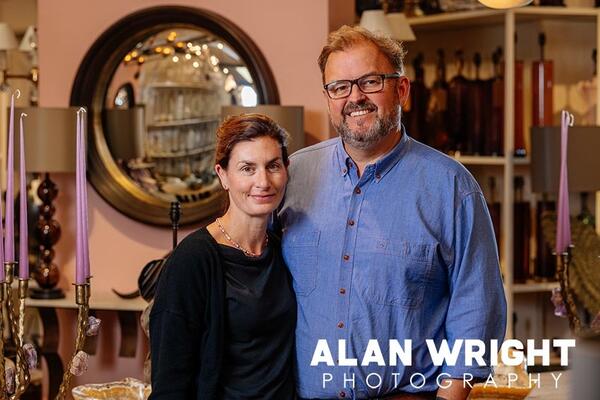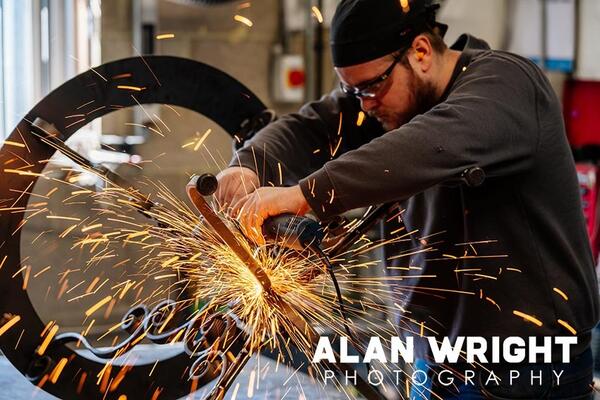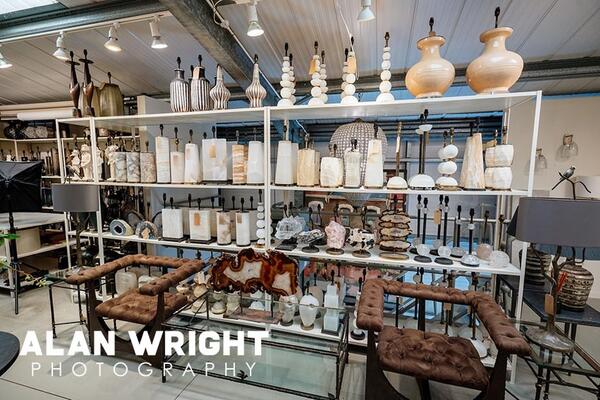STUNNING INTERIORS AT TYSON LONDON

Published on 1st November 2024
Tyson London is a decorative lighting and bespoke furniture specialist based in Horsham. Thanks to its incredible array of handcrafted pieces, the company works with some of the world’s leading interior designers. AAH met founder Tyson Bennison to find out more…
What do you do at Tyson London? We’re a leading supplier of lamps, lights and furniture, working with interior designers both in the UK and around the world. While major retailers have more customers than we do, they don’t maintain a stock of 600 different lamps made with from a wide range of materials in a variety of colours, putting us in a unique position. We also create furniture and decorative accessories, from bespoke wrought-iron tables and mirrors to hand-blown squiggle vases and onyx bowls.
Why do you appeal to interior designers? Designers seek out unique items that can’t be picked up off the shelf of a High Street store. They may be seeking a lamp or a piece of furniture made with a certain material to a specific size and colour. We’re very hands-on with our clients and treat them as friends, so we do our utmost to meet their demands through our in-house team of metalworkers, fabricators and glass-blowers.
You offer glass-blowing? We have a highly skilled glass-blower with many years of experience. Many of the finest glass-blowers in the world today are women, creating beautifully coloured and textured work. However, these tend to be smaller, ornamental pieces, and one of Phil’s talents is in shaping larger pieces. When you’re rotating heavy glass at the end of a six-foot pole in a furnace burning at 1,000 degrees Celsius, you need strength to manoeuvre and manipulate the glass. He does this, creating vases and lamp bases in countless colours. However, glass-blowing is expensive and recently our energy costs have soared from £1800 a month to about £5800. Unlike on the continent, we haven’t received any government support and that’s why glass-blowing is a dying art.
Are all of your lamps created with glass? As well as making our own glass lamps, we buy antiques, with a keen interest in pieces that originate in China and Japan, transforming them into functional lamps. It is unusual to take a 200-year-old antique worth thousands of pounds and bore a hole through it to create a lamp base, but that’s exactly what we do! In years to come, I expect one will appear on The Antiques Roadshow and an expert will remark about some idiot drilling through it! However, we like to create something new for clients that utilises the antique’s beauty.

Do you have overseas clients? We are a great export success story and half our sales come from abroad. Our clients include designers, private home owners, boutique businesses and even small hotels and guest houses. Labour costs are high in the UK and Brexit has made shipping more difficult, but there are still people who are happy to pay more for high quality British manufacturing.
Many of your pieces feature minerals…I’m fascinated by the beauty of rare minerals. Several times each year, I travel to a rural part of Brazil and buy minerals including agate and quartz directly from the miners. I buy a variety of rocks, some small and others 80cm in diameter, before they’ve even been split. There’s risk involved in this strategy, as some can be relatively featureless. However, others reveal amazing colour and clarity and I feel like a child on Christmas morning! I love Brazil and its people, but travelling to remote areas can be extremely dangerous.
How do you use these minerals? Some make for interesting ornamentals, such as agate slices, which come in a variety of colours including blue, brown and black. We also have paperweights and bookends made from rose quartz, green fluorite, pink Rhodonite, amethyst and other minerals, while the biggest agate slices can even be used as table tops. We also use minerals in hanging lights and chandeliers, while onyx makes stunning decorative bowls. We also have a contact in Perugia, Italy, who works with alabaster, which offers a subtle, sculptural blend of colours and can be used to create beautiful spherical lamp bases. By using these materials, we can create even more unique products for clients.
Where does your passion stem from? I was born and raised in Brisbane and as a child was obsessed with interiors. I must have been the only teenage boy in Australia who subscribed to World of Interiors Magazine! When I was 14, I came across a talented street artist and asked him to paint my house. When my dad came home, he found this artist up a ladder painting cherubs and clouds on the ceiling! My mum was quite obsessive when it came to interior design and dad collected antiques, so they both inspired me in certain ways. However, I carved out my own path and on my 18th birthday, paid $50 to change my surname from Smith to Bennison, in honour of Geoffrey Bennison, who in my opinion is the greatest ever interior decorator.

What brought you to England? I was employed as a rugby coach and taught at Eton for a while, but education wasn’t for me. Thirty years ago, Eton was full of antique shops and I loved browsing the town, buying bits and pieces. The idea of trading in antiques seemed like a wonderful thing to do for a living, so I set up a stall at Portobello Road Market. Having bought knick-knacks from sale rooms, I set up my stall and sold out within an hour. I was a fixture at Saturday’s market for several years, gradually developing my knowledge of antiques. I still love antiques and can’t resist unique pieces of furniture or tribal art that catch my eye. Building on the success of the market, I opened a shop on Fulham Road. When customers started asking for more of certain things, I found a workshop specialising in reproductions. That worked for a while, but employing people with different skills was costly and time consuming, so I established my own workshop in Battersea. Eventually, we had an eight-strong team which included metalworkers, electricians and decorators.
When did the business shift from retail to trade? We were based next door to Philip Treacy, the famous milliner, who became a good friend of ours. His array of hats and haute couture attracted the great and the good, and many visited our workshop too. So, we’ve sold to every style icon you can imagine! That was how the business took off and how we attracted leading designers too.
Why move to Horsham? Mary had joined the business, having previously worked as a nurse, to oversee the administrative aspects, allowing me to focus solely on the creative process. As our three children were getting older, we needed more space at home, so decided to move out of London. A relative of Mary’s introduced us to Horsham and we fell in love with it. We found a beautiful house in the town centre which took us a year to renovate, but we’re now settled as a family.
Have you considered opening a shop again? The pandemic has changed how business is conducted, so not having a showroom isn’t the end of the world and most of our business is done online. Clients simply tell us what they would like and we let them know if it’s feasible and what the cost will be. We have a website where people can buy from us at retail rates, but our trade prices are much more competitive. However, we have discussed opening a showroom in Horsham one day. The town is moving forward and has a great feel to it, so maybe the right time will come.
WORDS: Ben Morris / PHOTOS: Alan Wright
Further information: For more details about the range of products, visit the website at https://tyson.london/


